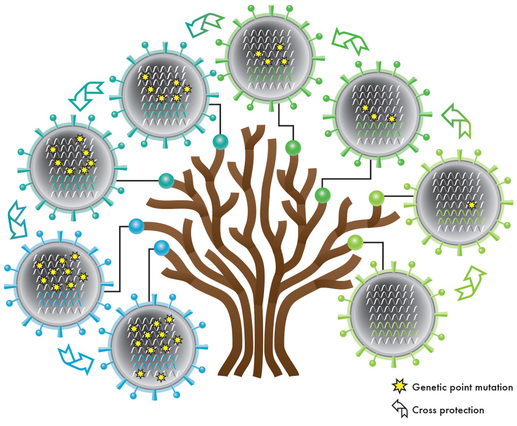As spring has finally sprung, colds and the flu should be fast becoming a distant memory. However, with the prolonged cold/hot/cold weather we’ve been experiencing in Washington, DC, as the cherry blossoms bloomed so too, has a new late-season flu virus. This has prompted a new wave of patients (including my husband) who, despite having had the flu shot back in November, have now become victims of this new strain of flu.
We have most likely just witnessed the phenomenon of antigenic drift. A new, progeny flu particle that has undergone a slight genetic mutation from its parent, is slightly different from that parent. And as time goes on replication occurs very rapidly. Mistakes in copying genetic material from one generation to the next occur, thus producing slight variations in each successive genome. What does this mean? As with a human parent and child, these flu particles are very closely related; therefore, they may also be similar enough to each other such that if our immune system is already primed to the parent, it will likewise be primed to the child.
This is called cross-protection.
Now, take a look at the graphic. I’m taking some liberties with this as technically I should be continuing out along one branch, to represent successive generations of parent to child viral progeny. But this is a prettier presentation!
Starting from the right-side and moving counter-clockwise, we see that as point mutations within the genome occur, if the flu particles are closer together on the tree, there is still cross-protection from our immune system afforded between these two flu particles. This is because they resemble each other so closely that our immune system may “mistake” the mutated version for the original version, and thus, our immune system quickly remembers it as bad, and the response mounted is thus swift and strong.
But as we look at flu particles farther away from each other on the tree, for instance across from each other on the tree, we see that cross-protection no longer occurs between the two distantly-related viruses. The mutations that have occurred have altered the virus so much that our immune system no longer recognizes it for the original that it knows. We have to then start from scratch with cells coming upon it, packaging it and presenting it to another cell to recognize it as bad, and then triggering our immune system to mount an adequate response.
This accumulation in point mutations make two flu viruses quite different. A primed immune system to one flu virus may also protect from the second, slightly altered flu virus. Over time, as more and more mutations occur, the resulting flu resembles the original less and less.
Mini pop quiz time! What is the difference between antigenic SHIFT and antigenic DRIFT? Answer, next post.
We have most likely just witnessed the phenomenon of antigenic drift. A new, progeny flu particle that has undergone a slight genetic mutation from its parent, is slightly different from that parent. And as time goes on replication occurs very rapidly. Mistakes in copying genetic material from one generation to the next occur, thus producing slight variations in each successive genome. What does this mean? As with a human parent and child, these flu particles are very closely related; therefore, they may also be similar enough to each other such that if our immune system is already primed to the parent, it will likewise be primed to the child.
This is called cross-protection.
Now, take a look at the graphic. I’m taking some liberties with this as technically I should be continuing out along one branch, to represent successive generations of parent to child viral progeny. But this is a prettier presentation!
Starting from the right-side and moving counter-clockwise, we see that as point mutations within the genome occur, if the flu particles are closer together on the tree, there is still cross-protection from our immune system afforded between these two flu particles. This is because they resemble each other so closely that our immune system may “mistake” the mutated version for the original version, and thus, our immune system quickly remembers it as bad, and the response mounted is thus swift and strong.
But as we look at flu particles farther away from each other on the tree, for instance across from each other on the tree, we see that cross-protection no longer occurs between the two distantly-related viruses. The mutations that have occurred have altered the virus so much that our immune system no longer recognizes it for the original that it knows. We have to then start from scratch with cells coming upon it, packaging it and presenting it to another cell to recognize it as bad, and then triggering our immune system to mount an adequate response.
This accumulation in point mutations make two flu viruses quite different. A primed immune system to one flu virus may also protect from the second, slightly altered flu virus. Over time, as more and more mutations occur, the resulting flu resembles the original less and less.
Mini pop quiz time! What is the difference between antigenic SHIFT and antigenic DRIFT? Answer, next post.


 RSS Feed
RSS Feed
